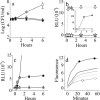Antibacterial properties and mode of action of a short acyl-lysyl oligomer
- PMID: 19487442
- PMCID: PMC2715605
- DOI: 10.1128/AAC.00010-09
Antibacterial properties and mode of action of a short acyl-lysyl oligomer
Abstract
We investigated the potency, selectivity, and mode of action of the oligo-acyl-lysine (OAK) NC(12)-2 beta(12), which was recently suggested to represent the shortest OAK sequence that retains nonhemolytic antibacterial properties. A growth inhibition assay against a panel of 48 bacterial strains confirmed that NC(12)-2 beta(12) exerted potent activity against gram-positive bacteria while exhibiting negligible hemolysis up to at least 100 times the MIC. Interestingly, NC(12)-2 beta(12) demonstrated a bacteriostatic mode of action, unlike previously described OAKs that were bactericidal and essentially active against gram-negative bacteria only. The results of various experiments with binding to model phospholipid membranes correlated well with those of the cytotoxicity experiments and provided a plausible explanation for the observed activity profile. Thus, surface plasmon resonance experiments performed with model bilayers revealed high binding affinity to a membrane composition that mimicked the plasma membrane of staphylococci (global affinity constant [K(app)], 3.7 x 10(6) M(-1)) and significantly lower affinities to mimics of Escherichia coli or red blood cell cytoplasmic membranes. Additional insertion isotherms and epifluorescence microscopy experiments performed with model Langmuir monolayers mimicking the outer leaflet of plasma membranes demonstrated the preferential insertion of NC(12)-2 beta(12) into highly anionic membranes. Finally, we provide mechanistic studies in support of the view that the bacteriostatic effect resulted from a relatively slow process of plasma membrane permeabilization involving discrete leakage of small solutes, such as intracellular ATP. Collectively, the data point to short OAKs as a potential source for new antibacterial compounds that can selectively affect the growth of gram-positive bacteria while circumventing potential adverse effects linked to lytic compounds.
Figures





References
Publication types
MeSH terms
Substances
Grants and funding
LinkOut - more resources
Full Text Sources
Medical
Molecular Biology Databases

